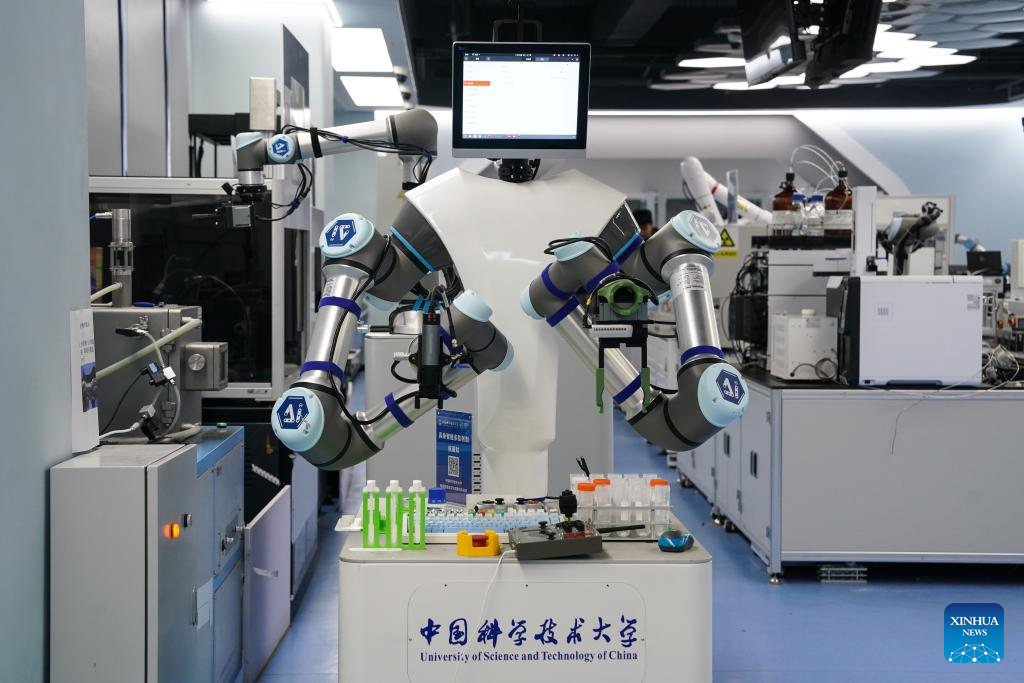
Traditional chemical research has long relied on continuous trial and error by scientists. With the development of artificial intelligence and robotic automation technologies, it has become possible to design experiments and issue instructions through intelligent platforms, using robots to replace human labor in experiential operations, which enhances experimental efficiency and precision.
In 2021, after eight years of dedicated effort by a research team from USTC, Xiaolai, the first-generation "robot chemist," was successfully developed. After several years of iterations, the second-generation dual-armed humanoid robot Xiaolin has been put into operation, capable of performing more complex tasks. It has evolved from a substitute of human labor to a "research partner."
According to Zhu Zhuoying, a professor from the state key laboratory of precision and intelligent chemistry at USTC, the team's ultimate goal is to enable robots to achieve fully autonomous scientific research. In the future, they might identify entirely new research directions by "reading" literature themselves and achieve breakthroughs in areas beyond human exploration. (Xinhua)

Researchers adjust robots at the state key laboratory of precision and intelligent chemistry of the University of Science and Technology of China (USTC) in Hefei, east China's Anhui Province, Nov. 24, 2025. (Xinhua/Du Yu)

Robot Xiaolin is pictured at the state key laboratory of precision and intelligent chemistry of the University of Science and Technology of China (USTC) in Hefei, east China's Anhui Province, Nov. 24, 2025. (Xinhua/Du Yu)

Robot Xiaolai performs an experiment at the state key laboratory of precision and intelligent chemistry of the University of Science and Technology of China (USTC) in Hefei, east China's Anhui Province, Nov. 24, 2025. (Xinhua/Du Yu)

Doctoral student Guo Lulu instructs an experiment via an intelligent platform at the state key laboratory of precision and intelligent chemistry of the University of Science and Technology of China (USTC) in Hefei, east China's Anhui Province, Nov. 24, 2025. (Xinhua/Du Yu)

Robot Xiaolin is pictured at the state key laboratory of precision and intelligent chemistry of the University of Science and Technology of China (USTC) in Hefei, east China's Anhui Province, Nov. 24, 2025. (Xinhua/Du Yu)

Professor Zhu Zhuoying (L) and doctoral student Chen Bingxu have a discussion at the state key laboratory of precision and intelligent chemistry of the University of Science and Technology of China (USTC) in Hefei, east China's Anhui Province, Nov. 24, 2025. (Xinhua/Du Yu)

Robot Xiaolai performs an experiment at the state key laboratory of precision and intelligent chemistry of the University of Science and Technology of China (USTC) in Hefei, east China's Anhui Province, Nov. 24, 2025. (Xinhua/Du Yu)

Professor Zhu Zhuoying (R) and doctoral student Guo Lulu have a discussion in front of Robot Xiaolin at the state key laboratory of precision and intelligent chemistry of the University of Science and Technology of China (USTC) in Hefei, east China's Anhui Province, Nov. 24, 2025. (Xinhua/Du Yu)

Robot Xiaolai performs an experiment at the state key laboratory of precision and intelligent chemistry of the University of Science and Technology of China (USTC) in Hefei, east China's Anhui Province, Nov. 24, 2025. (Xinhua/Du Yu)

86-10-68597521 (day)
86-10-68597289 (night)

52 Sanlihe Rd., Xicheng District,
Beijing, China (100864)

